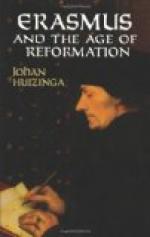But we may also make an instructive comparison between India and mediaeval, or even Renaissance, Europe. As soon as one gets away from the railway and the telegraph—indeed even where they have already penetrated—one still finds in India conditions prevailing which continued in Europe beyond the Middle Ages. The customary tie between master and servant, lasting from one generation to another, preserves the community of interest which prevented the feudal bond from being irksome. The modern severance of classes, the modern desire for aloofness, has not yet come. The servants are an integral part of the household, sharing in its ceremonies and festivities, crowding into their master’s presence without impairing his privacy, and following him as escort whenever he stirs abroad. The child-marriage which we condemn in modern India, was frequently practised in Europe in the sixteenth century, when the uncertainty of life made men wish to secure the future of their children so far as they could. The foster-mothers with whom young Mughal princes found a home, whose sons they loved as their own brothers, had their counter-part in these islands as late as the days of the great Lord Cork. Walled cities with crowded houses looking into one another across narrow winding alleys, were an inevitable condition of life in sixteenth-century Europe before strong central government had made it safe to live outside the gates. Even the houses of the great were dark, airless, cramped, with tiny windows and dim, opaque glass; such as one may still see at Compton Castle in Devonshire or the Chateau des Comtes at Ghent. Communications moved slowly along unmetalled roads or up and down rivers. Carriages with two or four horses were occasionally used; but the ordinary traveller rode on horseback, and needy students coming to a university walked, clubbing together for a packhorse to carry their modest baggage. These are features which may still be matched in many parts of India.
The ravages of plague, the absence of sanitation, the recurrence of famine and war, all combined in sixteenth-century Europe to produce an uncertainty in the tenure of life, which modern India knows only too well from all the causes except the last; but India does not follow Europe in the resulting practice of frequent remarriage on both sides. In Erasmus’ day a marriage in which neither side had previously or did subsequently contract a similar relation must have been quite exceptional. A certain German lady, after one ordinary husband, became the wife of three leading Reformers in succession, Oecolampadius, Capito, and Bucer—almost an official position, it would seem. She survived them all, and when Bucer died at Cambridge in 1551, was able to return to Basle, to be buried beside Oecolampadius in the Cathedral. Katherine Parr married four times. To her first husband, who left her a widow at fifteen, she was a second wife; to her second, a third wife; to her third, who was Henry VIII, a sixth; and only her fourth was a bachelor.




